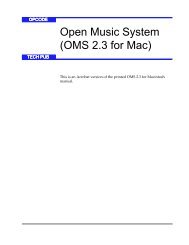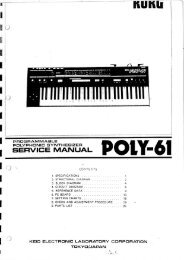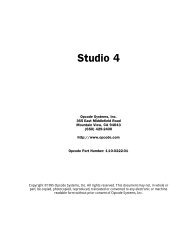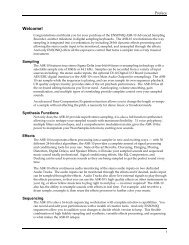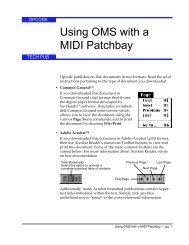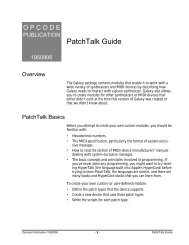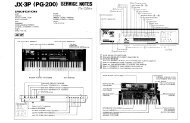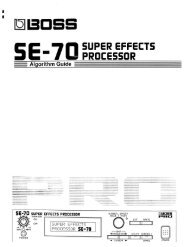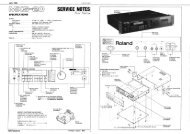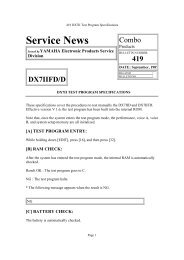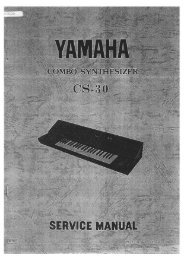Vision and Studio Vision Pro Version 4.1 Manual ... - House of Synth
Vision and Studio Vision Pro Version 4.1 Manual ... - House of Synth
Vision and Studio Vision Pro Version 4.1 Manual ... - House of Synth
You also want an ePaper? Increase the reach of your titles
YUMPU automatically turns print PDFs into web optimized ePapers that Google loves.
CHAPTER 1:<br />
Introduction<br />
This <strong>4.1</strong> <strong>Manual</strong> Supplement provides<br />
additional information not found in your<br />
MIDI <strong>and</strong> Audio Reference <strong>Manual</strong>s.<br />
Following is a short summary <strong>of</strong> the<br />
material in this manual:<br />
• Part 1: Introduction is what you are<br />
reading right now <strong>and</strong> provides a general<br />
overview <strong>of</strong> how you should<br />
proceed with your documentation.<br />
• Part 2: Summary <strong>of</strong> <strong>4.1</strong> Enhancements<br />
summarizes the feature changes in<br />
version <strong>4.1</strong> <strong>of</strong> <strong>Vision</strong> <strong>and</strong> <strong>Studio</strong><br />
<strong>Vision</strong> <strong>Pro</strong>.<br />
• Part 3: The Acadia Audio System discusses<br />
how to use the new Acadia<br />
audio system, which provides<br />
advanced digital audio capabilities for<br />
<strong>Vision</strong>. These chapters cover hardware<br />
configuration, recording,<br />
playback, audio processing, <strong>and</strong> optimization<br />
for digital audio.<br />
WHAT SHOULD I READ FIRST?<br />
After reading this introductory chapter,<br />
read the MIDI Reference <strong>Manual</strong>. It is<br />
the starting point for learning <strong>Vision</strong><br />
basics <strong>and</strong> contains tutorial <strong>and</strong> reference<br />
material for all <strong>of</strong> <strong>Vision</strong>’s MIDI features.<br />
Next, read Chapter 2 in this <strong>4.1</strong> Supplement.<br />
In addition to summarizing the<br />
feature changes since the printing <strong>of</strong> the<br />
MIDI <strong>and</strong> Audio Reference <strong>Manual</strong>s, it<br />
contains a review <strong>of</strong> the audio systems<br />
supported in <strong>Vision</strong> <strong>and</strong> <strong>Studio</strong><br />
<strong>Vision</strong> <strong>Pro</strong>.<br />
Next, read Chapters 1 <strong>and</strong> 2 in your<br />
Audio Reference <strong>Manual</strong>. These chapters<br />
introduce some basic digital audio<br />
concepts <strong>and</strong> terms.<br />
Next, read the chapters related to the<br />
audio system you will use with <strong>Vision</strong> or<br />
<strong>Studio</strong> <strong>Vision</strong> <strong>Pro</strong>.<br />
• If you will use the Acadia audio system,<br />
read Part 3: The Acadia Audio<br />
System in this <strong>4.1</strong> Supplement.<br />
• Or, if you intend to use one <strong>of</strong> the<br />
other audio systems, read either<br />
Part 2 (Sound Manager), Part 3<br />
(Yamaha CBX), or Part 4 (DAE) in<br />
the Audio Reference <strong>Manual</strong>.<br />
Finally, read Parts 5, 6, <strong>and</strong> 7 in your<br />
Audio Reference manual. These chapters<br />
discuss, in detail, all elements <strong>of</strong><br />
digital audio sequencing <strong>and</strong> editing.<br />
Figure 1.1:<br />
<strong>Vision</strong> & <strong>Studio</strong> <strong>Vision</strong> <strong>Pro</strong> — <strong>Version</strong> <strong>4.1</strong> <strong>Manual</strong> Supplement 3



